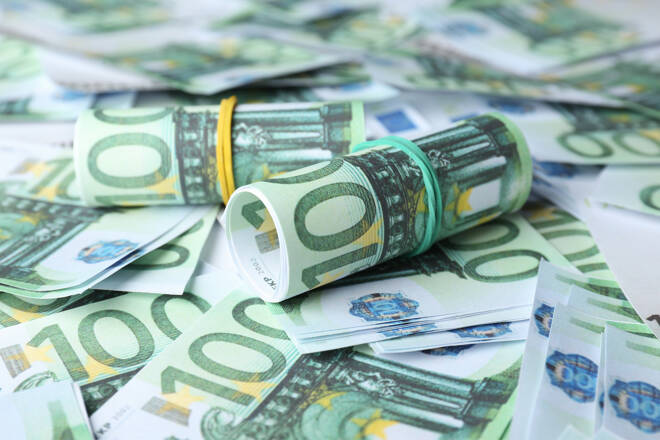Advertisement
Advertisement
EUR/USD Forecast: ECB Bulletin and Powell’s Influence on the Horizon
By:
Fed's focus on labor market data and Powell's views on rates may sway the EUR/USD outlook in the near term.
Highlights
- The EUR/USD gained 0.09% on Wednesday, ending the session at $1.07090.
- On Thursday, the ECB Economic Bulletin and ECB commentary will need consideration.
- Fed Chair Powell could also impact near-term EUR/USD trends later in the session.
Wednesday Overview
The EUR/USD gained 0.09% on Wednesday. Following a 0.16% loss on Tuesday, the EUR/USD ended the day at $1.07090. The EUR/USD fell to a low of $1.06592 before reaching a high of $1.07160.
ECB Economic Bulletin and ECB Commentary in the Spotlight
On Thursday, the ECB Economic Bulletin will garner investor interest. The ECB’s economic outlook, views on inflation, and monetary policy forward guidance will need consideration.
Recent macroeconomic indicators, including private sector PMIs, continue to fuel bets on a euro area economic recession. However, concerns over elevated inflation could force the ECB to keep interest rates higher for longer. A higher-for-longer interest rate environment would impact borrowing costs and disposable income.
Significantly, a downward trend in disposable income would impact private consumption and the Eurozone economy. Private consumption contributes over 50% to the Eurozone economy. However, a weaker outlook on consumer spending would ease demand-driven inflationary pressure and the need for a higher-for-longer interest rate path.
ECB President Christine Lagarde and Chief Economist Philip Lane are on the calendar to speak on Thursday. References to the economy, inflation, and interest rates will influence buyer appetite for the EUR/USD.
On Wednesday, ECB Chief Economist Philip Lane raised concerns about inflation. Lane’s views suggested the need for a higher-for-longer interest rate path.
Fed Chair Powell and the US Labor Market in Focus
On Thursday, initial jobless claims will garner investor interest. Recent labor market reports fueled bets on the Fed ending its rate hike cycle. A spike in jobless claims would align with sentiment toward the Fed interest rate path.
Economists forecast initial jobless claims to rise from 217k to 218k in the weekend ending November 4.
A weakening labor market environment would affect wage growth and consumer sentiment. Softer wage growth could lead to a downward trend in disposable income, affecting consumer spending. A pullback in consumer spending could ease demand-driven inflation and the need for a hawkish Fed rate path.
Beyond the numbers, Fed Chair Jerome Powell is on the calendar to speak on Thursday. Views on recent labor market reports and the likely effect on Fed interest rate intentions need consideration.
Short-Term Forecast:
Fed and ECB speeches will continue to dictate the near-term trends for the EUR/USD. However, a hawkish Fed could pressure the EUR/USD, considering the euro area macroeconomic backdrop.
EUR/USD Price Action
Daily Chart
The EUR/USD remained above the 50-day EMA while sitting below the 200-day EMA, sending bullish near-term but bearish longer-term price signals.
A EUR/USD break above the 200-day EMA would give the bulls a run at the $1.07838 resistance level.
The ECB Economic Bulletin and central bank speeches will be the focal points on Thursday.
However, a fall through the 50-day EMA and the $1.06342 support level would bring sub-$1.06 into view.
The 14-period Daily RSI, 58.94, suggests a EUR/USD move to the $1.07838 resistance level before entering overbought territory.
4-Hour Chart
The EUR/USD remains above the 50-day and 200-day EMAs, affirming bullish price signals.
A EUR/USD move through $1.07 would give the bulls a run at the $1.07838 resistance level and $1.08.
However, a break below the 50-day EMA would bring the $1.06342 support level and the 200-day EMA into play. Buying pressure may intensify at $1.0634. The 200-day EMA is confluent with the $1.06342 support level.
The 14-period RSI on the 4-hour chart, 57.57, suggests a EUR/USD move to the $1.07838 resistance level before entering overbought territory.
About the Author
Bob Masonauthor
With over 20 years of experience in the finance industry, Bob has been managing regional teams across Europe and Asia and focusing on analytics across both corporate and financial institutions. Currently he is covering developments relating to the financial markets, including currencies, commodities, alternative asset classes, and global equities.
Latest news and analysis
Advertisement
